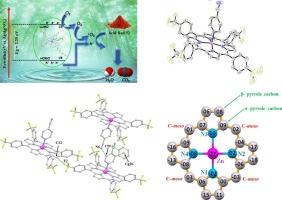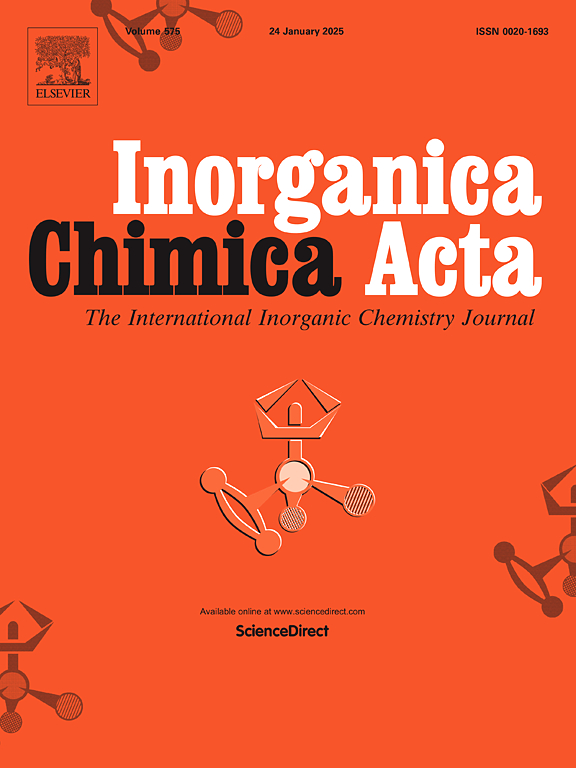Crystallographic insight and visible-light photodecolorization efficiency of a distinctive pentacoordinated zinc(II) porphyrin complex
IF 3.2
3区 化学
Q2 CHEMISTRY, INORGANIC & NUCLEAR
引用次数: 0
Abstract
A distinctive zinc(II) metalloporphyrin complex, formulated as [Zn(TMFPP)(4-CNpy)]•C6H5Cl•C6H14 (complex I), was synthesized and thoroughly examined through a combination of techniques, including elemental analysis, FT-IR spectroscopy, UV–Vis absorption, fluorescence emission, 1H NMR spectroscopy, and cyclic voltammetry. Its molecular structure was unambiguously determined via single-crystal X-ray diffraction, revealing a five-coordinate zinc center with 4-cyanopyridine occupying the axial position. The complex was evaluated as a visible-light-responsive photocatalyst for the decolorization of Acid Red 52 (AR52) dye in aqueous solution. It demonstrated significant photocatalytic activity, achieving a decolorization efficiency of 74 %, with a corresponding rate constant k = 0.00759 min−1 and correlation coefficient R2 = 0.9976, indicating a good fit to the applied kinetic model. Additionally, the effects of various experimental parameters including pH, initial dye concentration, temperature, and catalyst mass were assessed to better understand their roles in influencing the decolorization process. Scavenger experiments confirmed that superoxide radicals (•O2−) and singlet oxygen (1O2) are the primary reactive oxygen species responsible for the photodecolorization of AR52. These findings underline the promise of this zinc porphyrin complex as an effective photocatalyst for environmental remediation under visible-light irradiation.

一种独特的五配位锌(II)卟啉配合物的晶体学研究和可见光脱色效率
合成了一种独特的锌(II)金属卟啉配合物,分子式为[Zn(TMFPP)(4-CNpy)]•C6H5Cl•C6H14(配合物I),并通过元素分析、FT-IR光谱、UV-Vis吸收、荧光发射、1H NMR光谱和循环伏安法等技术进行了全面的研究。通过单晶x射线衍射明确了其分子结构,发现其具有一个五坐标锌中心,4-氰吡啶占据其轴向位置。研究了该配合物作为水溶液中酸性红52 (AR52)染料脱色的可见光响应光催化剂。其光催化活性显著,脱色效率为74%,相应的速率常数k = 0.00759 min−1,相关系数R2 = 0.9976,与应用动力学模型吻合良好。此外,还评估了各种实验参数(包括pH、初始染料浓度、温度和催化剂质量)的影响,以更好地了解它们对脱色过程的影响。清道夫实验证实,超氧自由基(•O2−)和单线态氧(1O2)是AR52光脱色的主要活性氧。这些发现强调了这种卟啉锌复合物作为可见光照射下环境修复的有效光催化剂的前景。
本文章由计算机程序翻译,如有差异,请以英文原文为准。
求助全文
约1分钟内获得全文
求助全文
来源期刊

Inorganica Chimica Acta
化学-无机化学与核化学
CiteScore
6.00
自引率
3.60%
发文量
440
审稿时长
35 days
期刊介绍:
Inorganica Chimica Acta is an established international forum for all aspects of advanced Inorganic Chemistry. Original papers of high scientific level and interest are published in the form of Articles and Reviews.
Topics covered include:
• chemistry of the main group elements and the d- and f-block metals, including the synthesis, characterization and reactivity of coordination, organometallic, biomimetic, supramolecular coordination compounds, including associated computational studies;
• synthesis, physico-chemical properties, applications of molecule-based nano-scaled clusters and nanomaterials designed using the principles of coordination chemistry, as well as coordination polymers (CPs), metal-organic frameworks (MOFs), metal-organic polyhedra (MPOs);
• reaction mechanisms and physico-chemical investigations computational studies of metalloenzymes and their models;
• applications of inorganic compounds, metallodrugs and molecule-based materials.
Papers composed primarily of structural reports will typically not be considered for publication.
 求助内容:
求助内容: 应助结果提醒方式:
应助结果提醒方式:


